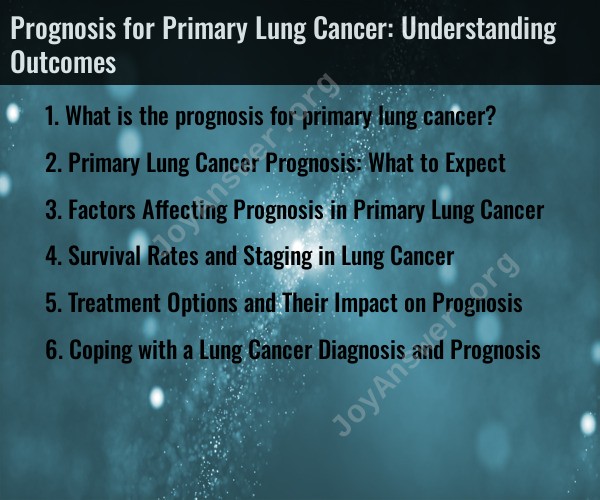What is the prognosis for primary lung cancer?
The prognosis for primary lung cancer can vary widely depending on several factors, including the type and stage of the cancer, the patient's overall health, and the effectiveness of treatment. Lung cancer is a complex disease with different subtypes, each of which may have a different prognosis. Here are some general points to consider:
Type of Lung Cancer:
- Non-Small Cell Lung Cancer (NSCLC): This is the most common type of lung cancer, and the prognosis can vary depending on the stage at diagnosis. Early-stage NSCLC typically has a better prognosis than advanced-stage NSCLC.
- Small Cell Lung Cancer (SCLC): Small cell lung cancer is often diagnosed at an advanced stage, and it tends to be more aggressive. The prognosis for SCLC is generally less favorable compared to NSCLC.
Cancer Stage:
- The stage at which lung cancer is diagnosed is a critical factor in determining prognosis. In general, the earlier the stage (stages I and II), the better the prognosis. Advanced stages (III and IV) are associated with a less favorable prognosis.
Tumor Size and Spread:
- The size of the tumor and whether it has spread to nearby lymph nodes or distant organs (metastasis) significantly impact prognosis.
Treatment Options:
- The type and success of treatment received also play a crucial role. Surgery, radiation therapy, chemotherapy, targeted therapies, immunotherapy, and other treatments can affect outcomes.
Overall Health and Age:
- The patient's overall health and age are important factors. Patients with better health and younger age may be better able to tolerate aggressive treatments.
Genetic and Molecular Factors:
- The presence of specific genetic mutations or molecular markers can affect prognosis and treatment choices. Some mutations may respond well to targeted therapies.
Response to Treatment:
- How well the cancer responds to treatment is a key factor. If treatment is successful in shrinking or eliminating the tumor, it can improve the prognosis.
Recurrence:
- The risk of cancer recurrence after treatment can impact long-term prognosis. Regular follow-up and monitoring are essential.
Smoking Status:
- Smoking is a major risk factor for lung cancer. Patients who continue to smoke after a lung cancer diagnosis may have a less favorable prognosis. Quitting smoking can improve outcomes.
It's important to note that lung cancer has a wide range of outcomes, and individual cases can vary significantly. To get the most accurate prognosis and personalized treatment options, it's crucial to consult with a healthcare provider who can assess your specific situation, including the cancer type, stage, and other relevant factors. Additionally, advancements in lung cancer research and treatment are ongoing, leading to more options and improved outcomes for many patients.
Primary Lung Cancer Prognosis: What to Expect
The prognosis for primary lung cancer varies depending on a number of factors, including the stage of the cancer at diagnosis, the type of lung cancer, the patient's age and overall health, and how well they respond to treatment.
In general, the earlier lung cancer is diagnosed and treated, the better the prognosis. For example, the 5-year survival rate for people with stage 1 non-small cell lung cancer (NSCLC), the most common type of lung cancer, is over 60%. However, the 5-year survival rate for people with stage 4 NSCLC is less than 5%.
Factors Affecting Prognosis in Primary Lung Cancer
The following factors can affect the prognosis in primary lung cancer:
- Stage of the cancer: The stage of the cancer at diagnosis is the most important prognostic factor. Early-stage cancers are more likely to be curable than late-stage cancers.
- Type of lung cancer: There are two main types of lung cancer: NSCLC and small cell lung cancer (SCLC). NSCLC is the most common type of lung cancer and has a better prognosis than SCLC.
- Patient's age and overall health: Younger patients and patients in overall good health are more likely to tolerate treatment well and have a better prognosis.
- Response to treatment: How well the patient responds to treatment can also affect their prognosis. Some patients may be more responsive to certain treatments than others.
Survival Rates and Staging in Lung Cancer
The following table shows the 5-year survival rates for lung cancer by stage and type:
| Stage | NSCLC | SCLC |
|---|---|---|
| 1 | 63% | 36% |
| 2 | 35% | 18% |
| 3 | 15% | 13% |
| 4 | 5% | 7% |
It is important to note that these are just averages. Individual survival rates can vary depending on the factors mentioned above.
Treatment Options and Their Impact on Prognosis
The treatment options for primary lung cancer vary depending on the stage of the cancer, the type of lung cancer, and the patient's overall health. Treatment options may include surgery, radiation therapy, chemotherapy, and targeted therapy.
The following are some of the most common treatment options for lung cancer and their impact on prognosis:
- Surgery: Surgery is the most effective treatment for early-stage lung cancer. It can cure cancer in many cases.
- Radiation therapy: Radiation therapy can be used to kill cancer cells or shrink them before surgery. It can also be used to treat lung cancer that cannot be removed with surgery.
- Chemotherapy: Chemotherapy uses drugs to kill cancer cells. It can be used to treat lung cancer at all stages.
- Targeted therapy: Targeted therapy uses drugs that target specific molecules involved in cancer cell growth and survival. It can be used to treat lung cancer that has spread to other parts of the body or that has stopped responding to chemotherapy.
Coping with a Lung Cancer Diagnosis and Prognosis
A lung cancer diagnosis can be a devastating experience. It is important to remember that you are not alone. There are many resources available to help you cope with your diagnosis and prognosis.
Here are some tips for coping with a lung cancer diagnosis and prognosis:
- Educate yourself about lung cancer. The more you know about your cancer, the better equipped you will be to make decisions about your treatment and care.
- Talk to your doctor about your prognosis. Ask them about your treatment options and what to expect.
- Seek support from your loved ones. Talk to your family and friends about your diagnosis and prognosis. They can offer you emotional support and practical help.
- Join a support group. There are many support groups available for people with lung cancer and their families. These groups can provide you with support and information from others who are going through the same experience.
If you have been diagnosed with lung cancer, it is important to stay positive and hopeful. With the right treatment and support, you can live a long and fulfilling life.











